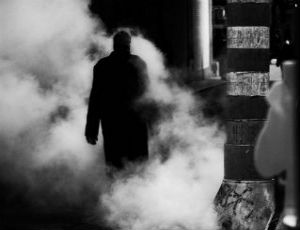Film noir is a style of black-and-white movies that first appeared in the early 1940s. The term film noir (literally "black film") was initially used by French film critics to describe and comment on the dark, downbeat looks and themes of many of the American crime movies released in French theaters following World War II.
Films such as The Maltese Falcon (1941), This Gun for Hire (1942) and Double Indemnity (1944) presented a slant on American everyday, war-time culture as displaying elements of tension and insecurity that belied Hollywood musicals and comedies, where Americans were all "Yankee Doodle Dandies."
After the war, film noir readily reflected the feelings of paranoia and angst that developed in the late 1940s and into the Cold War period of the 1950s. Film noir films (mostly shot in grim grays, blacks and whites using stark, expressionistic lighting, jarring editing and disorienting camera angles) emphasized the seedy, shadowy and sadistic aspects of the human condition. The violent, misogynistic, greedy anti-heroes portrayed in film noir were often war veterans, petty criminals, murderers or just "John Does."
Frequently, a film noir plot revolved around a cynical, world-weary male character like Humphrey Bogart or Robert Mitchum who encountered a ravishing, but amoral, corrupt femme fatale like Veronica Lake or Barbara Stanwyck, who would manipulate the male to his and her doom. Films reflecting these traits include Out of the past (1947), The Big Heat (1953) and Touch of Evil (1958). Touch of Evil, directed by Orson Welles, is generally considered the last classic film noir movie.
Much has been written about the film noir style and how it has affected numerous films to this day. The twisting storylines, the acerbic dialogue, the first-person voice-over narratives are just some of the staples of modern cinema that developed from film noir.
While you decide what to watch next, check out this clip from Out of the Past:



Add a comment to: Film Noir: Playing in Shadows